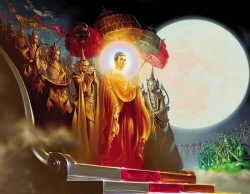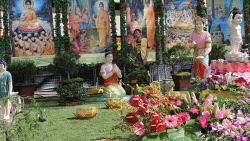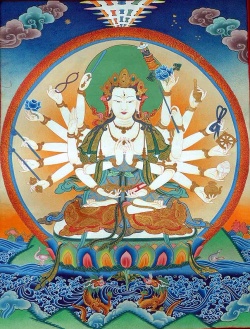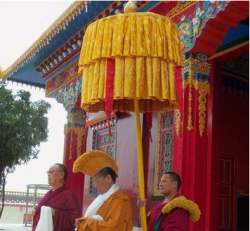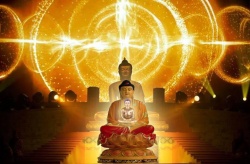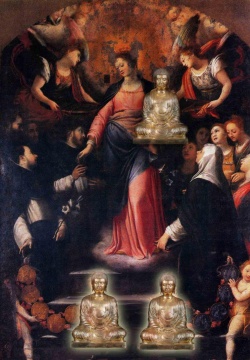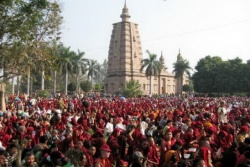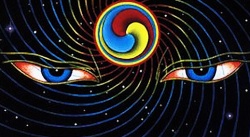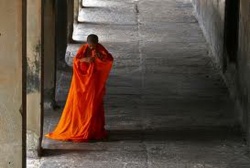God Agni as Kundalinî
The cult of fire as the inner immortal ruler who raises the mortal to the level of immortals, as the link between heaven and earth, the messenger between gods and men, the divine sacrificial priest whom man evoked at break of dawn, reached its apotheosis in early Vedic times. Subsequently, however, it was reduced to a mere ritual bereft of its original pristine spiritual significance. Yet the early understanding was not completely lost, because the knowledge of the secret fire reappears as kundalinî in the later Upanishads, the Tantras, and the medieval scriptures of Hatha-Yoga. This again bespeaks of the astounding continuity of transmission of spiritual from the early Vedic era to classical Hinduism.
Although the word kundalinî is not used in the Rig-Veda, nevertheless direct and indirect references to the discovery and actual arousal of such a dynamic psycho-spiritual power as leads to immortality, can be found in several addresses to God Agni, which clearly points to the antiquity of this esoteric lore.
Agni (Latin: ignis, "fire") is repeatedly declared to be that which lifts the mortal to highest immortality and is constantly praised in that quality. Whether these insights into the spiritual meaning of the sacred fire had already been systematized into an esoteric science is another question to which the Vedic Samhitâs unfortunately can provide no definite answer.
They only hint at certain ways of approach—by exertion of concentrated thought or by mantras—and certain results, specifically the discovery of the nectar of immortality. The highly symbolic language employed by the Vedic seers (rishi) lends itself to reasonable surmises but not to absolute certainty.
Expressions like "wind’s steed" (vâtasya ashvo), "wind’s friend" (vâyoh sakhâ)1 and "he endures/bears the fire" (agnim bibharti), 2 as well as others which will be discussed shortly are undoubtedly pointers to a certain body of knowledge concerning powers latent in the human being, though they do not demonstrate how far that arcane science had been developed. But given what we know about the intellectual and spiritual sophistication of the Vedic seers, we may justifiedly expect that they did in fact develop an early form of Kundalinî-Yoga.
The kundalinî is the dynamic power (shakti) inherent in the material body and is typically characterized as being of the nature of fire or luminosity. This aspect is borne out clearly in such passages as the following from the Shat-Cakra-Nirûpana (13): "By meditating thus on Her who shines within the mûla-(âdhâra-)cakra with the luster of ten million suns . . ."
The kundalinî is the power or energy of Shiva, the transcendental Consciousness (cit). There is no real difference between the kundalinî and Shiva; whereas Shiva is unchanging, the static aspect of Consciousness, the kundalinî-shakti is the kinetic, active aspect of the same transcendental Reality. The word kundalî or kundalinî is derived from the verbal root kund ("to encircle") and means literally "she who is coiled," that is, a serpent.3 The coils of the kundalinî—given as being three and a half or eight—suggest potentiality. What is implied is that this power must be deliberately awakened, stirred into action. In the ordinary person it is said to be "asleep." Hence the ordinary person also is "asleep," that is, unaware of the subtle dimension of existence.
Indeed, the Tantric scriptures insist that the dormant kundalinî is responsible for a person’s bondage (bandha), that is, entrapment in the world of change and suffering. In the "awakened" person, who has become Shiva, the kundalinî also is fully aroused, making available its full potential manifesting in bliss (ânanda).
In broad terms, the impact in the human being of the action of the serpent fire can be summed up as the movement from heterogeneity to homogeneity, from chaos to cosmos, from multiplicity to unity. Its dormancy is an expression of matter (i.e., the human body) in its primordial, formless, unorganized state. But when aroused and rendered active, the serpent power becomes the means whereby matter is energized and organized into one harmonious whole.
It is noteworthy that it is the combined action of mind and life force (prâna) that produce that individual cosmos. The intimate link between mind and life force (via the breath) was a discovery of the Vedic seers or perhaps even earlier navigators of the spiritual realms. It became a cornerstone of Yoga practice, particularly Hatha-Yoga. As the Hatha-Yoga-Pradîpikâ (2.3) declares:
So long as the "wind" remains in the body, that long there is said to be life. Its [the breath's] departure is death. Therefore one should [carefully] restrain the "wind."
The serpent (ahi) of legendary fame, Vritra, which Indra smites with his thunderbolt, may have been an early Rig-Vedic representation of the idea of kundalinî . For Vritra is the constrictor, that which holds the waters, or the riches of heaven, back from flooding the earth, but which when brought under control by the mind, symbolized by God Indra, who strikes Vritra’s head with his thunderbolt or light of clear consciousness, lets out that which had been kept hidden.4
Whatever geographical or metereological interpretations we may want to attach to this Vedic myth, we cannot ignore its symbolic-metaphysical import. Words like "unawakened" (abudhya) or "fast asleep" (abudhyamâna) used to describe Vritra distinctly point to a process in consciousness. They are not employed arbitrarily, as the Vedic seers were masters of language and poetic metaphor.
Heaven itself, declares the seer of hymn 1.52.10 in glowing hyperbolic language, "reeled back in terror" when Indra’s thunderbolt with might rent asunder the head of Vritra, the latter being described as the "constrictor of both worlds." A. A. Macdonell, an early translator of the Rig-Veda, was of the opinion that there was an earlier meaning to Vritra because of the use of the word in the plural, which "can hardly be derived from a generalization of the proper name Vritra but must be based on an earlier meaning such as ‘obstruction’, then ‘obstructor.’"5
A somewhat similar idea of obstruction is found in the Babylonian creation myth where Marduk dismembers the dragon Tiamat or chaos and from this action the world comes into being. Similarly, from the dismembered body of the giant Ymir (as also the Vedic Purusha) in the Norse cosmogony the world is fashioned. But whereas these myths deal primarily with the creation of order out of chaos on the cosmic level, the idea of kundalinî creating a cosmos out of chaos applies to the individual or microcosmic level.
The ambivalence of the kundalinî energy, its life- and death-giving power, is hinted at in one of the earlier works on Hatha-Yoga, the Goraksha-Shataka (58) where the word itself is used:
kanda-ûrdhvam kundalî-shaktir ashtadhâ kundala-âkritih, bandhanâya ca mûdhânâm yogînâm moksha-dâ smritâ.
"Above the ‘bulb’ the kundalî power, coiled eightfold, is said to lead the foolish to bondage and to grant emancipation to the yogins."
In the Rig-Veda, God Agni in his manifold manifestations is the mighty energy ("thou Agni art highest vital power," 2.1.12), the life- and death-bestowing flame, the healer and the killer, at the root of all things, including human beings (cf. 2.1). He is the treasure found far away (3.9.5) in heaven or the highest firmament (1.143.2), but also is deeply hidden (guhâ, 1.141.3) or crouching in the "cavern," holding dynamic might in his hand (1.67.2). This particular aspect of the Vedic fire, insofar as it may reveal a connection with the science of kundalinî, has hardly been investigated.
Several descriptions in the Rig-Veda bear a resemblance to those of the later literature on the kundalinî and are worth examining in that respect. Hymns 1.148, 1.141.3, 7.1.1, 6.16.13 all have the idea of "churning up" the fire, which could be taken as examples of the Vedic method of kindling fire, but when juxtaposed with such medieval texts as those of the Yoga-Kundalî-Upanishad and the Hatha-Yoga-Pradîpikâ may also bear another meaning. The Tantric texts commonly use the ancient term manthana ("churning") to describe the process by which the serpent power is aroused.
This immediately reminds one of the Puranic myth of the churning of the primordial ocean to produce precious objects: The gods (deva) and antigods (asura) respectively gripped the head and tail of the cosmic serpent, which was wrapped around the cosmic mountain, and twirled the mountain at great speed, thus churning the waters.
According to some Tantric schools, the sleeping place of the serpent power in the human body has associated with it Shiva’s emblem, the linga, a representation of omnipresent creativity but often misinterpreted as a phallus. Some texts even describe the serpent power as being wrapped around the linga, covering with the linga’s top with its head.
Perhaps the Vedic figure of Ahirbudhnya, the serpent of the deep, expresses the same idea. Significantly, according to Yâska’s Nirukta, the term budhnya ("depth") refers to the body. Moreover, the same fundamental notion could be preserved in the classical symbolism of God Vishnu reclining on the cosmic serpent, Shesha (or Ananta).
In stanza 3 of the Rig-Vedic hymn 1.141, the process of drawing forth the fire is described, and though it may be argued that only fire by attrition can be referred to here, since the fire is produced by means of strength (savas), there is no certainty that this strength is purely physical, that it does not refer as well to mental concentration which is also a "power," required both for kindling the fire physically and raising the kundalinî.
Hymn 7.1.1 mentions the arani as producing fire, but also "deep thought":
"Men absorbed in deep meditation, have with their hands’ fast motion produced auspicious Agni from the kindled-wood."
This could be contrasted with the Yoga-Kundalî-Upanishad (1.11-12):
"The wise man . . . should, by his own effort, move [the vital energy stirring up the kundalinî ] from right to left again and again for a period of two muhûrtas [i.e., 48 minutes] without fear."6
The motion from right to left bears a strange resemblance to the kindling of fire by friction. On the other hand, the idea of physical force necessary for the production of fire according to the Vedic method may be compared with the moral force or courage necessary to arouse the inner, spiritual fire which prepares man for the nectar of immortality by granting him vigor and courage. This is clearly expressed in the Rig-Vedic hymn 3.25.2:
"Agni, the knower, procures heroic might, procures vigor, enhancing it for immortality."
A curious statement of Agni reclining upon "auspicious mothers" is made in hymn 1.141.2:
"Self-sustaining, wondrous, eternally rich in nourishment is he; secondly, he reclines upon the seven auspicious mothers; thirdly, the songs of praise make him manifest so that, from that mighty one, the tenfold provider may be drawn forth."
The meaning of the seven "auspicious mothers" is controversial. Sâyana explains them as the rain which fertilizes the seven worlds. In this particular context the mothers could be taken to refer to the "wheels" (cakra) of potent energy, the seven main centers of the life force which are pervaded by latent fire but become active only when the kundalinî rises, stirs them up and bathes them completely.
According to the Rig-Vedic hymn 1.141.5, Agni, pure, unharmed, pervaded the mothers, and in them increased in size; such a description could be read as the kundalinî rising along the cakras, activating each of these, such action in turn reacting upon the fire itself; this, according to Kundalinî-Yoga is supposed to confer upon the consciousness a deepening and a widening beyond imagination. This idea could be indicated by the words urviyâ vivavridhe, "he waxes widely."
In the last pâda of 1.141.2, the word yoshanâ given out as "maiden" in dictionaries, may, following Sâyana’s hints, be equivalent to stuti or "hymn." Already the first stanza of the same hymn had declared that the songs of the rite or voices (considered as cows) have caused their breath to fall on him (i.e., Agni) that inspired thought (matis) may thus "succeed" (sâdhate).
All these strange metaphors may imply that by means of their rhythmic chants the priests were able to draw forth or "milk out" the treasures of Agni, those treasures which are elsewhere described as "immortal bounty" (1.72.1), as vâja, for whomsoever strives after immortality (3.25.2); "treasures" very similar to those granted by the kundalinî .
Concealment and power and treasures latent in Agni are the three basic ideas worth further investigation. Concentration, patience, steadiness, are part of that will power which has to be exerted to arouse the kundalinî and which as the words îshânâsah and savasâ of hymn 1.141.3 give us to understand are similarly qualities necessary for bringing forth Agni:
"Whenever from the depth of his mighty form priests with power brought him forth through their prowess as when of old Mâtarishvan churned him up in order to stir the ambrosia as he lay hidden."
Agni’s concealment, churning, and the goal expressed above as "stirring the ambrosia," or in hymn 3.25.2 as "striving after immortality," attest to an early knowledge of the fire not in its mere physical aspect which by itself is no means of attaining immortality.
Rather, these motifs suggest a psycho-spiritual meaning that envisages a purposive activity designated by the seers as the "ruler of thought" (4.6.1) and as that power which can be aroused by thought and enhanced by songs (8.44.19). If Agni were purely the physical fire, what could be the meaning of the following wish?
"As cows reach their dwelling at eve, so may we [too reach] the kindled-god." (1.66.5)
In hymn 1.65.1, the story is retold of the gods tracking Agni "like a thief lurking in a dark cave." In another hymn (1.67.2) he is found "seated in secret place." The sight of Agni "deeply hidden" may "strike the gods with fear" because of the mighty power which they realize he holds in his hands. No other power save that of the kundalinî can arouse such awe.
Yet this first part of 1.67.2 lends itself to a different translation, for ama means "strength," "power," "violence" as well as "terror"; thus, "he stabilized the gods in power" is a possible rendering. Either translation, however, accentuates the idea of might. Furthermore, it is clearly stated that men absorbed in deep reflection find him there, i.e., concealed or abiding in the cavern.
This hiding place also described as kha ("cave," 4.11.2) or vavra ("cavern," 4.1.13) is the innermost center whence emerges the visionary thought that enlightens and makes the seer what he is.
Kha is a cavity or hollow, and from this depth Agni is begged in hymn 4.11.2 to draw out or release the inspired vision (manîshâ) lying latent therein. These words are the equivalent of the "heart" and therefore of the "hollow" in the heart, as used in the Upanishads. This discovery of Agni hidden in the cave is furthered by the pronouncing of certain sacred mantras formed within men’s heart (1.67.2).
Meditating in their heart—that center where Varuna set kratu, or divine understanding (5.85.2), which alone gives depth and power to any thought or utterance revealing divine wisdom (1.105.15)—they find the effectual words to strike the right keynote; through its vibratory power this keynote evokes a response from the center where Agni-kundalinî is lying at rest. We have here a combination of thought concentration that effects the sounding of the required note, which in turn will result in arousing Agni or discovering him "crouched in the cavern."
Such is the typical method of the Rig-Vedic seers, whose knowledge of sound seems to have been much deeper than is generally conceded. Hymn 8.44.19 states that "by means of thoughts . . . those who understand," the wise ones, stimulate Agni.
So let our songs, adds the verse, that is, let the power of the word or sound, "enhance thee." Such a verse confirms the Vedic belief that the fire can be aroused and stimulated by the vibratory power inherent in sound, if the concentration is deep enough.7
The whole idea, which hinges upon concentration of mind, can thus be brought into line with the later doctrine that through concentrated thought acting upon prâna, which presses upon the cakra at the base of the spine, the kundalinî is aroused. Hymn 1.67.4 gives further insights:
"Whosoever has perceived Agni abiding in secret and whosoever has watched the direction of the ritual (rita) [a term which also means "law," "order," and "truth"], when, working in accordance with the ritual they release him [i.e., Agni), to such a one has he promised riches."
This verse, it may be argued, refers only to the sacrificial rite, but it may be counter-argued, the arousal of the kundalinî strangely resembles a ritual, an inner ritual that bestows blessings or riches that are not merely material, and immortality can be gathered from many of the verses that describe him.
"Agni is the rich lord of riches," declares hymn 1.72.1, but the treasures he grants are of the immortal kind. In him the sacrificers discovered hidden the thrice seven seats by which they lovingly protect the nectar of immortality (1.72.16).
The state of immortality seems thus concealed in Agni: he is the "lord of abundant amrita" (7.4.6) and is made the center of immortality by the gods (3.17.4).
In like manner, the kundalinî, when it pervades the top cakra, dissolves the last barriers of limited consciousness and opens up full cosmic awareness untrammeled by any limitation of time and space and thereby confers immortality.
The very emphasis on concealment and on power, not merely necessary to draw forth Agni but actually conferred by Agni on his devotees granting them that energy which strives after immortality (3.25.2), should indicate that there is in question not something purely physical or imaginary, but a very potent force hidden in the human being; in other words, the kundalinî dynamic energy may be described here in a language that precedes that of the Tantras and which therefore had its own vocabulary different from that of later periods.
The idea of law, "righteousness," "truth" as well as "rite" contained in the Vedic word rita, points in the same direction. Agni is lord of the ritual, but the ritual is a microcosmic expression of the cosmic law.
The danger of arousing kundalinî-shakti without being morally prepared has been sufficiently emphasized not to need any comment here,8 except to point out the Vedic linking of the idea of law, righteousness, and Agni. In this respect, hymn 1.67.4 could be interpreted thus: Whosoever watches the stream of holy law, whosoever performs righteous deeds and thereby reflects the true order of things, Agni will call down blessings upon him.
Agni rises from the "womb of the ritual" (4.1.12), which is the expression of the law, the balance between the outgoing and ingoing forces, the law of give and take, of offering and receiving, for he is "born in order" (6.7.1). The idea of law and sacrifice as combined in the thought of Agni can be seen in the following:
"By the path of rita we invoke that performer of sacrifice." (1.128.2)
Therefore he can be found only insofar as man abides by law. Sacrifice is part of the Great Law, life itself is a ritual. It is characteristic that Atharvan, one of the early seers who is related to have drawn Agni out of his hidden dwelling, practiced austerity:
"Atharvan first laid down the paths through sacrifice." (1.83.5)9
This Atharvan, furthermore, is reported to have "churned up Agni from the lotus flower" (6.16.13)—a doubly significant verse, because the verb "churn" is used in connection with the "lotus," the latter being explained in the Mahâbhârata as a metaphorical expression for the "heart," or heart cakra. When it is remembered that the cakras were in the post-Vedic age compared to lotus flowers, this verse could be taken as evidence that Agni is already being described here in his kundalinî aspect: he is churned up from the cakra in order to be manifested.
The question of sacrifice is bound up with that of tapas, a word that has many shades of meaning. A. C. Bose’s definition stresses ". . . not self-mortification, but self-awakening by activising the spiritual power within oneself."10
It is not mere austerity or mere heat, though the physical reaction to contemplative exertion does result in heat, but fundamentally the spiritual energy liberated from the innermost center of the human being through the process of concentration, absorption, enstasis.
In the Yoga-Sûtra (2.1;32), tapas is connected with purification, contentment, self-study or discipline, austerity and surrender to the divine will—all spiritual practices that throw some light on the real meaning of the word. In the Yoga-Sûtra (2.43) it is stated that through fiery aspiration (tapas) and through the removal of imperfections, the perfecting of the bodily powers and sense organs is brought about.
Through the practice of tapas, impurities are destroyed.
But tapas was also considered as that power which underlies the process of cosmic unfoldment, for through its creative and liberating dynamism the worlds were brought into manifestation. According to hymn 10.129.3, through the flame-power of tapas the universe was made manifest:
"Enwrapped in voidness, that which flame-power (tapas) kindled to existence emerged."
Again in hymn 10.190.1 we have:
"Cosmic Order (rita) and truth (satya) were born of blazing tapas."
It was through his "glowing with tapas" that Indra won heaven (10.167-1). The practice of tapas thus leads to the conquest of light, in other words, to an awakening to a higher state of consciousness.
The verbal root of pari-tap, as used in the above quotation, means "to burn all around," or "to set on fire," a setting on fire obviously beyond the physical kindling, since it leads to heaven (svar).
The fire of the spirit, which in one hymn of the Atharva-Veda (7.61.1) the poet invokes in order "that we may kindle the fire of the spirit by this very fire," must be referred to in the Rig-Vedic hymn 8.60.16, where Agni is reputed to "cleave through the rock with his tapas and radiance."
This fire is that spiritual energy which cleaves through the rock of matter, or inertia, and arouses man to inspired deeds.
In consonance with typical Vedic imagery and myths according to which the sun is rent from his hiding place in the mountain cave and the kine or rays of light are set free, we may have here a reference to Agni’s action as the kundalinî cleaving through the various plexuses of the body.
This recalls hymn 10.136.7, where Vâyu, the master of prâna, is said to pound or grind and churn up the "unbendable" (kunamnamâ)—material nature summed up in the term tamas or "inertia," one of the three primary qualities or energies of prakriti, which has to be brought under control and therefore made a pliable tool before the yogin can achieve mastery over himself.
Cleaving through the rock, pounding the unbendable, and churning—these three ideas point to the significance of Agni’s work, namely a bringing forth out of the rock-like nature of that which the fire must overcome, of the treasure locked in matter or entombed in the body: the very action of the kundalinî . Here again we are reminded of the myth of the dragon-serpent Vritra who has to be slain or brought under control before the real work of molding chaos into cosmos can be accomplished.
In the mythological language of the Rig-Veda, as a result of the taming of that which obstructed, the waters are released and the sun is set up on high, i.e., the spiritual element is set free, and Indra modifies the darkness by means of the sun. Furthermore, Indra finds the nectar of immortality in its triple splendor stored away in heaven (6.44.23).
Agni is said to have been brought by Mâtarishvan "from far away" (1.128.2). Apart from the fact that the word mâtarishvan is a name and, moreover, very probably a name borne by one of the first men to have achieved supreme realization, it has a specific meaning, which may throw some light on the particular aspect of Agni under consideration.
It is composed of two parts, matari and shvan (from shvi "to swell"): that which swells or expands in the mother, here presumably the fire or dynamic energy which animates all things in the mother, Aditi, or primordial substance. Agni, "when formed in his mother is mâtarishvan" says hymn 3.29.11, but, the verse continues, he becomes the "gust of wind" in his wandering.11
Mâtarishvan, as the messenger of Vivasvat who represents the divine, solar origin of the human race since Yama (the son of Vivasvat) is the father of mortal man, brought forth Agni from afar (6.8.4).
He brought him forth "churned about" (3.9.5) "from far away, from the gods." The idea of "far away" or "from the gods" should preclude any purely physical origin of the fire as hidden in wood, or stone and brought to manifestation by friction.
This fire is the gift of the gods and makes of man an immortal, "Thou raisest the mortal to highest immortality" (1.31.7).
That immortality is also kept in Vâta’s home (10.186.3), an interesting remark, as Vâta or Vâyu is the Lord of prâna, and the right wielding of prâna in turn arouses the kundalinî by which the nectar is released.
Agni, as the gods’ tongue, is the guardian of this ambrosial liquid, the "undeceived keeper of immortality" (6.7.7), and in him is hidden "the thrice seven seats" whereby the gods, of one mind, protect the amrita (1.72.6).
This is quite a revealing verse if we consider Agni as kundalinî. The word pâda may mean "step," "abode," "locality" and possibly "state" and "ray" of light. Griffith translates this part of the verse as "thrice seven mystic things contained within thee."
Does the enumeration imply degrees of a deepening state of bliss-consciousness, so that pâda would here mean states of enlightenment such as are experienced when the kundalinî "bathes" each cakra, and such as open up in man and take him step by step to supreme consciousness? The Rig-Veda, as always, gives no answer.
As Agni pervades all things and is the immortal "guest" or "king immortal of the mortals" (3.1.18), the envoy from the gods, he is naturally the conductor to that thrice hidden abode, that mysterious seat where the unborn (aja) holds sway, which hymn 8.61.9 describes as the "lofty, unshakable" home of Varuna.
It may be surmised that the immortal essence, which is Agni’s flame and gift and which the Yajur-Veda (34.1-6) explains as "the light immortal in all creatures without which no single action could be performed," hints at the twofold course of life—involution and evolution:
thus the hidden potentiality has to be lifted out of the subconscious or dark level of nature or man where it is embedded as the reflection of heaven on earth, to the realms of light and divine freedom, for actual realization.
Unconscious in nature, it becomes conscious in man. In other words, only when the full union is effected between prakriti and purusha, between energy-fire and light spirit, or the kundalinî and Shiva—when Agni has linked heaven and earth in man—can there be conscious liberation.
For Agni in the Rig-Veda, as the supreme agent in matter and in man, raises up the potential immortality hidden in nature and nature’s child, man, to the loftiness of actual immortality, i.e., unlimited consciousness. This is the great work of Agni,12 as it is that of the kundalinî
.
NOTES
1. Rig-Veda 10.136.5.
2. Rig-Veda 10.136.1.
3. For a study of the kundalinî, see A. Avalon (Sir John Woodroffe), The Serpent Power (Madras: Ganesh, 10th ed. 1974).
4. The slaying of Vritra symbolizes not the "production," as Wilson would have it, but the conquering of matter after which the "light of heaven" is won. Cf. Rig-Veda 1.51.4; 1.52.8; 2.19.2; 8.89.4.
5. A. A. Macdonell, Vedic Mythology (Strassburg, 1897), p.159.
6. Cf. also Hatha-Yoga-Pradîpikâ (3.112): "the serpent should be made to move daily for about an hour and a half morning and evening."
7. Cf. Rig-Veda 1.127.7; 10.122.5.
8. The Gandharva-Tantra lists the requirements for a sâdhaka to be accepted as such, as intelligence, sense control, harmlessness, good deeds, purity and faith. See A. Avalon, The Serpent Power, p. 201. See also the Shat-Cakra-Nirûpana (50).
9. Cf. Rig-Veda 1.80.16; 10.87.12; 10.92.10.
10. A. C. Bose, Hymns from the Vedas (London, 1966), p. 8.
11. It may be of interest to note that as the kundalinî rises, it is reported to produce a hissing sound like the wind.
12. Cf. Rig-Veda 1.31.7; 1.96.6; 6.7.7.
